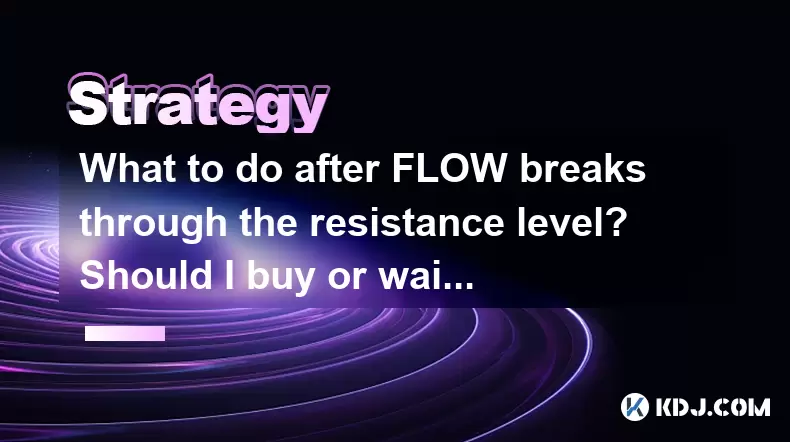-
 bitcoin
bitcoin $122025.899241 USD
-2.12% -
 ethereum
ethereum $4488.068729 USD
-4.11% -
 bnb
bnb $1315.348019 USD
8.65% -
 tether
tether $1.000457 USD
0.03% -
 xrp
xrp $2.875326 USD
-3.69% -
 solana
solana $222.043604 USD
-4.07% -
 usd-coin
usd-coin $0.999682 USD
0.00% -
 dogecoin
dogecoin $0.249887 USD
-5.62% -
 tron
tron $0.337379 USD
-2.59% -
 cardano
cardano $0.827763 USD
-5.06% -
 hyperliquid
hyperliquid $45.774531 USD
-2.43% -
 chainlink
chainlink $22.079309 USD
-5.87% -
 ethena-usde
ethena-usde $1.000156 USD
0.02% -
 sui
sui $3.482566 USD
-3.57% -
 stellar
stellar $0.386982 USD
-4.92%
What to do after FLOW breaks through the resistance level? Should I buy or wait and see when the callback occurs?
After FLOW breaks through a resistance level, investors should analyze volume, candlestick patterns, and market sentiment before deciding to buy immediately or wait for a callback.
May 07, 2025 at 03:07 pm

When FLOW, a cryptocurrency token associated with the Flow blockchain, breaks through a resistance level, it is a critical moment for investors and traders to make decisions about their next steps. Understanding the implications of this breakout and the potential subsequent movements of the token's price can help in deciding whether to buy immediately or to wait for a possible callback. This article will delve into the strategies and considerations that should be taken into account after FLOW breaks through a resistance level.
Understanding Resistance Levels and Breakouts
Resistance levels are price points at which a cryptocurrency, such as FLOW, tends to encounter selling pressure, preventing the price from rising further. When FLOW breaks through a resistance level, it suggests that the token has gained enough buying momentum to overcome this barrier. This breakout can be interpreted as a bullish signal, indicating potential for further price increases.
However, it's crucial to understand that not all breakouts lead to sustained upward movements. Sometimes, a breakout may be followed by a callback or a retracement, where the price pulls back to test the former resistance level, which now may act as a support level. This scenario can provide a second chance to enter a position at a potentially lower price.
Analyzing the Breakout
Before making any trading decisions, it's essential to analyze the nature of the breakout. Consider the following factors:
- Volume: A breakout accompanied by high trading volume is generally considered more reliable than one with low volume. High volume indicates strong interest and commitment from traders.
- Candlestick Patterns: Look for confirmation patterns such as a strong bullish candlestick or a series of bullish candles following the breakout.
- Market Sentiment: Assess the overall sentiment in the cryptocurrency market. Positive news or developments related to FLOW can enhance the likelihood of a sustained upward trend.
Should You Buy Immediately After the Breakout?
The decision to buy FLOW immediately after a breakout depends on your trading strategy and risk tolerance. If you are a momentum trader, you might be inclined to buy right away to capitalize on the upward momentum. However, this approach comes with higher risk, as there is no guarantee that the price will continue to rise.
- Pros of Buying Immediately: You can potentially ride the upward trend and secure profits if the price continues to rise.
- Cons of Buying Immediately: You might buy at the peak, and if a callback occurs, you could face immediate losses.
Waiting for a Callback: A More Conservative Approach
For those who prefer a more conservative approach, waiting for a callback can be a prudent strategy. A callback can provide an opportunity to enter a position at a lower price, reducing the risk of buying at the peak.
- Identify the Callback: Monitor the price closely after the breakout. A callback typically occurs within a short period, often within a few days or weeks.
- Set Entry Points: Determine specific price levels at which you would be comfortable buying FLOW. These levels should be based on technical analysis, such as Fibonacci retracement levels or previous support levels.
- Use Stop-Loss Orders: To manage risk, consider placing a stop-loss order below the callback level to limit potential losses if the price continues to fall.
Technical Analysis Tools for Decision Making
Utilizing technical analysis tools can help in making informed decisions about whether to buy FLOW immediately or wait for a callback. Some useful tools include:
- Moving Averages: The 50-day and 200-day moving averages can help identify trends and potential support levels.
- Relative Strength Index (RSI): An RSI above 70 might indicate that FLOW is overbought, suggesting a potential callback, while an RSI below 30 could indicate an oversold condition.
- Bollinger Bands: A price movement outside the upper Bollinger Band can signal a potential breakout, while a return within the bands might indicate a callback.
Implementing the Strategy
Here's how you can implement your chosen strategy after FLOW breaks through a resistance level:
- If Buying Immediately:
- Monitor the breakout closely and ensure it is accompanied by high volume and bullish candlestick patterns.
- Place a buy order at the current market price.
- Set a stop-loss order below the breakout level to manage risk.
- If Waiting for a Callback:
- Identify potential callback levels using technical analysis tools.
- Set price alerts at these levels to notify you when FLOW reaches them.
- Once the callback occurs, place a buy order at the predetermined entry point.
- Use a stop-loss order below the callback level to protect against further declines.
Frequently Asked Questions
Q: How can I tell if a breakout is false or a trap?A: A false breakout, or a breakout trap, occurs when the price briefly breaks through a resistance level but then quickly reverses. To identify a potential false breakout, look for the following signs:
- Low Volume: If the breakout occurs on low trading volume, it may lack the necessary buying pressure to sustain the upward movement.
- Quick Reversal: If the price quickly reverses and falls back below the resistance level within a short period, it could indicate a false breakout.
- Lack of Follow-Through: If subsequent price action does not show continued bullish momentum, the breakout may be a trap.
A: Key indicators to watch for a potential callback include:
- RSI Divergence: If the RSI starts to diverge from the price action (e.g., the price continues to rise while the RSI starts to fall), it could signal an impending callback.
- Moving Average Convergence/Divergence (MACD): A bearish crossover in the MACD can indicate weakening momentum and a potential callback.
- Price Action: Look for signs of exhaustion in the price, such as long upper wicks on candlesticks, which can indicate that the price is struggling to maintain its upward momentum.
A: To use stop-loss orders effectively after buying FLOW:
- Determine Your Risk Tolerance: Decide how much you are willing to lose on the trade and set your stop-loss order accordingly.
- Place the Stop-Loss Below Key Levels: For a breakout, place the stop-loss just below the breakout level. For a callback, place it below the callback level or a recent low.
- Adjust the Stop-Loss as the Price Moves: As FLOW's price moves in your favor, consider adjusting the stop-loss to lock in profits and minimize potential losses.
A: In addition to technical analysis, consider the following factors:
- Fundamental Analysis: Evaluate FLOW's fundamentals, such as the strength of the Flow blockchain, recent developments, and partnerships.
- Market Conditions: Assess the broader cryptocurrency market conditions. A bullish market can enhance the likelihood of a successful breakout.
- Regulatory News: Keep an eye on any regulatory news that could impact FLOW's price, as regulatory developments can significantly influence cryptocurrency markets.
Disclaimer:info@kdj.com
The information provided is not trading advice. kdj.com does not assume any responsibility for any investments made based on the information provided in this article. Cryptocurrencies are highly volatile and it is highly recommended that you invest with caution after thorough research!
If you believe that the content used on this website infringes your copyright, please contact us immediately (info@kdj.com) and we will delete it promptly.
- BlockDAG, DOGE, HYPE Sponsorship: Crypto Trends Shaping 2025
- 2025-10-01 00:25:13
- Deutsche Börse and Circle: A StableCoin Adoption Powerhouse in Europe
- 2025-10-01 00:25:13
- BlockDAG's Presale Buzz: Is It the Crypto to Watch in October 2025?
- 2025-10-01 00:30:13
- Bitcoin, Crypto, and IQ: When Genius Meets Digital Gold?
- 2025-10-01 00:30:13
- Stablecoins, American Innovation, and Wallet Tokens: The Next Frontier
- 2025-10-01 00:35:12
- NBU, Coins, and Crypto in Ukraine: A New Yorker's Take
- 2025-10-01 00:45:14
Related knowledge

Practical parameter settings for a Bitcoin multi-timeframe moving average system
Sep 18,2025 at 10:54pm
Optimizing Timeframe Combinations for Bitcoin Trading1. Selecting appropriate timeframes is crucial when building a multi-timeframe moving average sys...

How can I filter out false breakouts in Dogecoin high-frequency trading?
Sep 22,2025 at 01:00am
Understanding False Breakouts in Dogecoin Trading1. A false breakout occurs when Dogecoin's price appears to move beyond a defined support or resistan...

Techniques for identifying tops and bottoms in the Bitcoin on-chain NVT model
Sep 20,2025 at 07:54pm
Understanding the NVT Model in Bitcoin Analysis1. The Network Value to Transactions (NVT) ratio is often described as the 'P/E ratio' of the cryptocur...

What does the surge in open interest in Bitcoincoin futures mean?
Sep 20,2025 at 11:18pm
Understanding the Surge in Dogecoin Futures Open Interest1. A surge in open interest within Dogecoin futures indicates a growing number of active cont...

How can I use the Ethereum USDT premium to gauge market sentiment?
Sep 18,2025 at 11:55pm
Understanding the Ethereum USDT Premium1. The Ethereum USDT premium refers to the price difference between USDT (Tether) traded on Ethereum-based plat...

What should I do if Ethereum staking yields decline?
Sep 20,2025 at 06:18am
Understanding the Causes Behind Declining Ethereum Staking Yields1. The Ethereum network transitioned to a proof-of-stake consensus mechanism with the...

Practical parameter settings for a Bitcoin multi-timeframe moving average system
Sep 18,2025 at 10:54pm
Optimizing Timeframe Combinations for Bitcoin Trading1. Selecting appropriate timeframes is crucial when building a multi-timeframe moving average sys...

How can I filter out false breakouts in Dogecoin high-frequency trading?
Sep 22,2025 at 01:00am
Understanding False Breakouts in Dogecoin Trading1. A false breakout occurs when Dogecoin's price appears to move beyond a defined support or resistan...

Techniques for identifying tops and bottoms in the Bitcoin on-chain NVT model
Sep 20,2025 at 07:54pm
Understanding the NVT Model in Bitcoin Analysis1. The Network Value to Transactions (NVT) ratio is often described as the 'P/E ratio' of the cryptocur...

What does the surge in open interest in Bitcoincoin futures mean?
Sep 20,2025 at 11:18pm
Understanding the Surge in Dogecoin Futures Open Interest1. A surge in open interest within Dogecoin futures indicates a growing number of active cont...

How can I use the Ethereum USDT premium to gauge market sentiment?
Sep 18,2025 at 11:55pm
Understanding the Ethereum USDT Premium1. The Ethereum USDT premium refers to the price difference between USDT (Tether) traded on Ethereum-based plat...

What should I do if Ethereum staking yields decline?
Sep 20,2025 at 06:18am
Understanding the Causes Behind Declining Ethereum Staking Yields1. The Ethereum network transitioned to a proof-of-stake consensus mechanism with the...
See all articles










































































